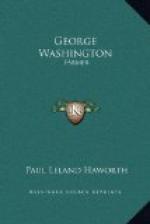Much of Washington’s youth was spent with Lawrence at Mount Vernon, and as an aside it may be remarked here that the main moulding influence in his life was probably cast by this high-minded brother, who was a soldier and man of the world. By the time he was sixteen the boy was on the frontier helping Lord Thomas Fairfax to survey the princely domain that belonged to his lordship, and received in payment therefor sometimes as much as a doubloon a day. In 1748 he patented five hundred fifty acres of wild land in Frederick County, “My Bullskin Plantation” he usually called it, payment being made by surveying. In 1750 he had funds sufficient to buy four hundred fifty-six acres of land of one James McCracken, paying therefor one hundred twelve pounds. Two years later for one hundred fifteen pounds he bought five hundred fifty-two acres on the south fork of Bullskin Creek from Captain George Johnston. In 1757 he acquired from a certain Darrell five hundred acres on Dogue Run near Mount Vernon, paying three hundred fifty pounds.
It is evident, therefore, that very early he acquired the “land hunger” to which most of the Virginians of his day were subject, as a heritage from their English ancestry. In the England of that day, in fact, no one except a churchman could hope to attain much of a position in the world unless he was the owner of land, and until the passage of the great Reform Bill in 1832 he could not even vote unless he held land worth forty shillings a year. In Virginia likewise it was the landholder who enjoyed distinction and consideration, who was sent to the House of Burgesses and was bowed and scraped to as his coach bumped along over the miserable roads. The movement to cities did not begin until after the Industrial Revolution, and people still held the healthy notion that the country was the proper place in which to live a normal human existence.
In 1752 Lawrence Washington died. As already stated, he was the proprietor by inheritance of Mount Vernon, then an estate of two thousand five hundred acres which had been in the Washington family since 1674, being a grant from Lord Culpeper. Lawrence had fought against the Spaniards in the conflict sometimes known as the war of Jenkins’s Ear, and in the disastrous siege of Cartagena had served under Admiral Vernon, after whom he later named his estate. He married Anne Fairfax, daughter of Sir William Fairfax, and for her built on his estate a new residence, containing eight rooms, four to each floor, with a large chimney at each end.
[Illustration: Mount Vernon, Showing Kitchen to the Left and Covered Way Leading to It]




